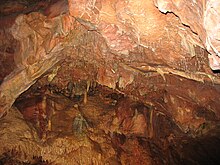Kents Cavern
Kents Cavern , also known as Kents Hole , is a large limestone cave in the town of Torquay , in the south of the English county of Devon . In the oldest known cave dwelling in Britain there are Paleolithic traces of human existence along with those of extinct animals. The prehistoric finds partially have an age of about 450,000 years. The stalactites of the cave are still worth seeing today .
exploration
Father J. McEnery was probably the first to recognize the importance of the upper sites he examined between 1825 and 1829. He had found flint tools mixed with Pleistocene animal bones and covered by a layer of stalagmite . The excavations carried out by William Pengelly from 1865 to 1880 finally provided clear evidence. Also involved were John Evans , Hugh Falconer and Joseph Prestwich . In the course of time, a total of six layers of deposits were discovered. The topmost contained pieces from the Roman , Early Iron, and Bronze Ages . These included polished stone and metal artifacts , pottery, and human bones. In addition to human bones and tools, the lower, paleolithic layers also contained bones from mammoths , fur rhinos , reindeer and giant deer .
At Kent's Cavern, significant finds have also been made by Neanderthals who settled the southern, unglaciated part of Great Britain around 60,000 years ago.
Particularly noteworthy is a part of a human upper jaw found in 1927 (fossil name KC 4 , safekeeping location: Torquay Museum), which was aptly described as an anatomically modern human being in Arthur Keith's first publication . An AMS Direct dating in 1989 yielded an uncalibrated age of 30,900 ± 900 years BP (oxa-1621). AMS data obtained in 2011 with ultrafiltration on animal bones from the same layer could show that the calibrated age of the upper jaw can be set at 44,200 to 41,500 cal BP. If the dating is correct, the fragment would be among the oldest remains of modern man in Europe and older than the Red Lady of Paviland . However, in 2012 it was pointed out that the exact location of the fossil had not been documented with sufficient accuracy; therefore it is not certain that the fossil layer was actually dated.
Tourist use
Kents Cavern was acquired by Francis Powe in 1903 and has been in the family ever since. Originally used for commercial purposes, paved paths and electric lights were later installed in the cave. With 80,000 visitors a year, Kents Cavern is a major tourist attraction for Torquay.
See also
literature
- Encyclopædia Britannica: Britannica CD 99 Multimedia Edition
Individual evidence
- ^ Joyce Lundberg, Donald A. McFarlane, Pleistocene depositional history in a periglacial terrane: a 500 ky record from Kents Cavern, Devon, United Kingdom. In: Geosphere. Vol. 3, No. 4, 2007, ISSN 1553-040X , pp. 199-219, doi : 10.1130 / GES00085.1 .
- ↑ Arthur Keith : Report on a fragment of a human jaw. In: Transactions and Proceedings. Torquay Natural History Society. Vol. 5, 1927, pp. 1-2.
- ^ SEM Hedges, RA Housley, IA Law, CR Bronk: Radiocarbon dates from the Oxford AMS system: Archaeometry datelist 9. In: Archaeometry. Vol. 31, No. 2, 1989, pp. 207-234, doi : 10.1111 / j.1475-4754.1989.tb01015.x .
- ^ Tom Higham et al .: The earliest evidence for anatomically modern humans in northwestern Europe. In: Nature . Vol. 479, 2011, pp. 521-524, doi : 10.1038 / nature10484
- ↑ The Mysterious Affair at Kents Cavern. On: sciencemag.org of August 3, 2012.
Web links
- Web site Kents Cavern (English)
Coordinates: 50 ° 28 ′ 1 ″ N , 3 ° 30 ′ 12 ″ W.
